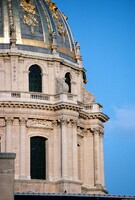Invalides: Église du Dome
Mansart, Jules Hardouin

Download1A2-F-P-I-1-D3_cp.jpg (541.1Kb)
Alternative Title
Dôme des Invalides
Date
1676-1735Description
In 1676 he was commissioned to build the church of the Hôtel des Invalides, after Libéral Bruand, who designed the rest of the complex, failed to produce a satisfactory scheme. For this almost monastic establishment for disabled soldiers, Hardouin Mansart created a bipartite building: the first part [Église St-Louis], a nine-bay nave for the pensioners, has a barrel vault and side aisles with tribunes opening through flattened arches, following 17th-century French models. The second part, beyond, is the 'great church', the Dôme, in the form of a Greek cross inscribed in a square and vaulted by a dome on a drum--a plan that Hardouin Mansart borrowed from his great-uncle's [François] designs for the 'rotunda' Bourbon chapel at Saint-Denis Abbey. The exterior of the church was conceived to give maximum emphasis to the dome, which dominates all the other buildings of the Invalides as well as the church itself. This was achieved by the insertion of an attic storey over the drum and by the graceful silhouette of the outer dome, with its extremely tall lantern and crowning obelisk, together reaching more than 100 m above the ground. The interior was renovated from 1840-1861; Napoleon's body was brought back from Saint Helena in 1840.; In 1676 he was commissioned to build the church of the Hôtel des Invalides, after Libéral Bruand, who designed the rest of the complex, failed to produce a satisfactory scheme. For this almost monastic establishment for disabled soldiers, Hardouin Mansart created a bipartite building: the first part [Église St-Louis], a nine-bay nave for the pensioners, has a barrel vault and side aisles with tribunes opening through flattened arches, following 17th-century French models. The second part, beyond, is the 'great church', the Dôme, in the form of a Greek cross inscribed in a square and vaulted by a dome on a drum--a plan that Hardouin Mansart borrowed from his great-uncle's [François] designs for the 'rotunda' Bourbon chapel at Saint-Denis Abbey. The exterior of the church was conceived to give maximum emphasis to the dome, which dominates all the other buildings of the Invalides as well as the church itself. This was achieved by the insertion of an attic storey over the drum and by the graceful silhouette of the outer dome, with its extremely tall lantern and crowning obelisk, together reaching more than 100 m above the ground. The interior was renovated from 1840-1861; Napoleon's body was brought back from Saint Helena in 1840. Source: Grove Art Online; http://www.groveart.com/ (accessed 12/2/2007)
Type of Work
church; sepulchral chapelSubject
architectural exteriors, military, war, Louis XIV, King of France, 1638-1715, Napoleon I, Emperor of the French, 1769-1821, Baroque, Eighteenth century
Rights
Rights Statement
Licensed for educational and research use by the MIT community only